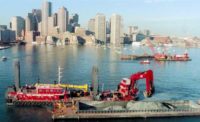A small tunnel boring machine has been stalled since June only yards away from the finish of a 1,586-ft-long sewer line relocation under Los Angeles Harbor by undetected sandy conditions in a pit excavated to remove the TBM. The problems will delay completion by several months and increase the project's $13.6-million cost by at least $1 million, reports the contractor, WestCon Microtunneling Inc., Pleasant Grove, Utah.
The utility relocation is one of several required for a $167-million channel deepening project. By September 2004, a joint venture of Great Lakes Dock & Dredge Co. and Manson Construction Co. is scheduled to complete dredging the channel from 45 to 53 ft deep to accommodate larger-capacity container ships. Click here to view chart
Although the dredging is so far unaffected by the delays, "We're watching the situation very closely," says Gerald Lum, assistant chief harbor engineer with the Port of Los Angeles. Eight lines in all are slated for relocation. The owner has already earmarked $7 million to move three other utility lines, he says.
An official close to the project says the Los Angeles Dept. of Public Works' bureau of engineering selected microtunneling for the 30-in. force main even though the project was "clearly an excellent choice for directional drilling." The department did not respond to repeated requests for comment. But in a September request for additional funding, engineering staff acknowledge "that the city may be liable for a portion of the cost" and that WestCon had attempted "diligently" and "in good faith...to resolve the problem."
WestCon will relocate a 30-in.-dia sewer force main, currently buried under some 12 ft of cover, to 31 ft below the dredged main channel. About 1 mile north, the company will increase coverage for two 20-in.-dia sewer siphons from about 10 to 19 ft.
But "the soils weren't quite what we expected" in the 105-ft-deep, 13-ft-wide reception shaft, says Roger M. Ellis, WestCon's project manager. The tunneling contractor expected groundwater to be contained by a silt layer; instead it bubbled up through a previously unknown sandy layer.
WestCon, which had selected soil freezing to shore the pit before encountering the sandy conditions, tried several other methods before using more expensive jet grouting. It stopped the leaks, but also added hundreds of thousands of dollars to the project's cost.
The 51-in.-dia Soltau open-face TBM had attained what Ellis calls a "really good production" of 70 to 80 ft per day through mostly clay deposits. But the TBM could not complete excavation before the reception shaft, and eventually became stuck, possibly jammed by water and sand in its workings, he says. WestCon plans to hand-excavate from the reception shaft to the TBM and determine whether it should be removed or left partly in place.



Post a comment to this article
Report Abusive Comment